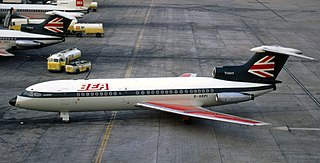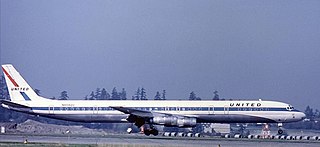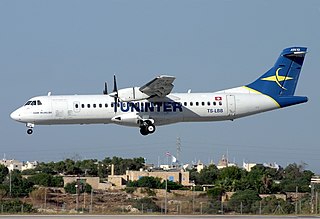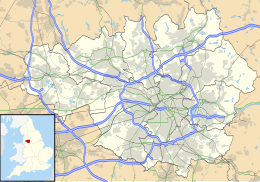
An aviation accident is defined by the Convention on International Civil Aviation Annex 13 as an occurrence associated with the operation of an aircraft, which takes place from the time any person boards the aircraft with the intention of flight until all such persons have disembarked, and in which (a) a person is fatally or seriously injured, (b) the aircraft sustains significant damage or structural failure, or (c) the aircraft goes missing or becomes completely inaccessible. Annex 13 defines an aviation incident as an occurrence, other than an accident, associated with the operation of an aircraft that affects or could affect the safety of operation.

British European Airways Flight 548 was a scheduled passenger flight from London Heathrow to Brussels that crashed near Staines, England, shortly after take-off on 18 June 1972, killing all 118 people on board. The accident became known as the Staines air disaster. As of 2024, it remains the deadliest air accident in the United Kingdom and was the deadliest air accident involving a Hawker Siddeley Trident. One passenger initially survived the impact but died of his injuries soon after.

The Kegworth air disaster occurred when British Midland Airways Flight 092, a Boeing 737-400, crashed onto the motorway embankment between the M1 motorway and A453 road near Kegworth, Leicestershire, England, while attempting to make an emergency landing at East Midlands Airport on 8 January 1989.

On 25 July 2000, Air France Flight 4590, a Concorde passenger jet on an international charter flight from Paris to New York, crashed shortly after takeoff, killing all 109 people on board and four on the ground. It was the only fatal Concorde accident during its 27-year operational history.

Air Transat Flight 236 was a transatlantic flight bound for Lisbon, Portugal, from Toronto, Canada, that lost all engine power while flying over the Atlantic Ocean on August 24, 2001. The Airbus A330 ran out of fuel because of a fuel leak caused by improper maintenance. Captain Robert Piché, 48, an experienced glider pilot, and First Officer Dirk DeJager, 28, glided the plane to a successful emergency landing in the Azores, saving all 306 people on board. Most of the passengers on the flight were Canadians visiting Europe or Portuguese expatriates returning to visit family in Portugal. This was also the longest passenger aircraft glide without engines, gliding for nearly 75 miles or 121 kilometres. Following this unusual aviation accident, this aircraft was nicknamed the "Azores Glider".

Pan Am Flight 214 was a scheduled flight of Pan American World Airways from Isla Verde International Airport in San Juan, Puerto Rico, to Friendship Airport near Baltimore, and then to Philadelphia International Airport. On December 8, 1963, the Boeing 707-121 serving the flight crashed near Elkton, Maryland, while flying from Baltimore to Philadelphia, after being hit by lightning. All 81 occupants of the plane were killed. The crash was Pan Am's first fatal accident with the 707, which it had introduced to its fleet five years earlier.

On 26 June 1950, a Douglas DC-4 Skymaster aircraft departed from Perth, Western Australia, for an eight-hour flight to Adelaide, South Australia. It crashed 22 minutes after take-off, 35 miles (56 km) east of Perth Airport. All 29 occupants were killed in the accident; one initially survived, but died six days later. It was the worst civil aviation accident in Australia.

Bellview Airlines Flight 210 was a scheduled Nigerian domestic passenger flight of a Boeing 737-200 airliner from Lagos to Abuja, operated by Lagos-based Bellview Airlines. On 22 October 2005, the aircraft nose-dived and crashed at high speed just a few minutes after take-off, killing all 117 people on board.

Sosoliso Airlines Flight 1145(SO1145/OSL1145) was a scheduled Nigerian domestic passenger flight from Nigeria's capital of Abuja (ABV) to Port Harcourt (PHC). At about 14:08 local time on 10 December 2005, Flight 1145 from Abuja crash-landed at Port Harcourt International Airport. The aircraft, a McDonnell Douglas DC-9-32 with 110 people on board, slammed into the ground and burst into flames. Immediately after the crash, seven survivors were recovered and taken to hospitals, but only two people survived.

In an internal combustion engine, fuel starvation is the failure of the fuel system to supply sufficient fuel to allow the engine to run properly, for example due to blockage, vapor lock, contamination by water, malfunction of the fuel pump or incorrect operation, leading to loss of power or engine stoppage. There is still fuel in the tank(s), but it is unable to get to the engine(s) in sufficient quantity. By contrast, fuel exhaustion is an occurrence in which the vehicle in question becomes completely devoid of usable fuel, with results similar to those of fuel starvation.

United Airlines Flight 173 was a scheduled flight from John F. Kennedy International Airport in New York City to Portland International Airport in Portland, Oregon, with a scheduled stop in Denver, Colorado. On December 28, 1978, the aircraft flying this route ran out of fuel while troubleshooting a landing gear problem and crashed in a suburban Portland neighborhood near NE 157th Avenue and East Burnside Street, killing 10 on board.

ADC Airlines Flight 053 (ADK053) was a scheduled passenger flight operated by ADC Airlines from Nigeria's capital of Abuja to Sokoto. On 29 October 2006, the Boeing 737-2B7 crashed onto a corn field shortly after take-off from Nnamdi Azikiwe International Airport in Abuja, killing 96 out of 105 people on board.

Advance Airlines Flight 4210 was a scheduled passenger flight which crashed at Sydney Airport on 21 February 1980, killing all 13 people on board the Advance Airlines Beech Beechcraft King Air 200. After taking off on runway 25 for a scheduled flight the aircraft's left (port) engine failed and the pilot requested an emergency landing on runway 34. The plane crashed into the sea wall while attempting the emergency landing. The accident caused the greatest number of fatalities in a civil aircraft crash in Australia since MacRobertson Miller Airlines Flight 1750, a Vickers Viscount that crashed near Port Hedland in Western Australia on 31 December 1968 killing all 26 on board.

Tuninter Flight 1153 was a Tuninter Airlines international flight from Bari International Airport in Bari, Italy, to Djerba-Zarzis Airport in Djerba, Tunisia. On 6 August 2005, the Tuninter ATR 72 ditched into the Mediterranean Sea about 18 miles (29 km) from the city of Palermo. Sixteen of the 39 people on board died. The accident resulted from fuel exhaustion due to the installation of fuel quantity indicators designed for the ATR 42 in the larger ATR 72. It was also Tuninter's first fatal accident in the 14-year history of the company.

Caspian Airlines Flight 7908 was a scheduled commercial flight from Tehran, Iran, to Yerevan, Armenia, that crashed near the village of Jannatabad, outside the city of Qazvin in north-western Iran, on 15 July 2009. All 153 passengers and 15 crew on board died.

Dana Air Flight 0992 was a scheduled Nigerian domestic passenger flight from Abuja to Lagos, Nigeria. On 3 June 2012, the McDonnell Douglas MD-83 aircraft serving the route suffered a dual-engine failure during its approach to Lagos. It failed to reach its intended destination and crashed onto buildings, killing all 153 people on board and six on the ground. With 159 deaths, it remains as the deadliest commercial airliner crash in Nigerian history since the Kano air disaster in 1973.

Vieques Air Link Flight 901A was a flight from Vieques Airport in Vieques, Puerto Rico, to St. Croix, United States Virgin Islands that crashed on August 2, 1984, killing all nine passengers and crew on board.

On 6 December 1997 a Russian Air Force Antonov An-124-100, en route from Irkutsk Northwest Airport to Cam Ranh Air Base in Vietnam, crashed in a residential area after takeoff from the airport.

Aero Flight 217 was a domestic passenger flight from Helsinki, Finland, to Mariehamn in the autonomous territory of Åland, operated by the Finnish flag carrier Aero O/Y. On 8 November 1963, the aircraft serving the flight crashed in poor visibility while attempting to land on a non-precision approach at Mariehamn Airport in the municipality of Jomala, resulting in the deaths of 22 people out of 25 on board. The crash remains the second most deadly aviation accident in Finland, the first being Aero Flight 311 almost two years earlier.





















